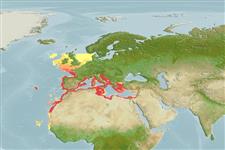Preferred temperature (Αναφ.
123201): 12 - 18.4, mean 14.8 °C (based on 156 cells).
Phylogenetic diversity index (Αναφ.
82804): PD
50 = 0.5156 [Uniqueness, from 0.5 = low to 2.0 = high].
Bayesian length-weight: a=0.01096 (0.00950 - 0.01265), b=3.06 (3.03 - 3.09), in cm total length, based on LWR estimates for this species (Ref.
93245).
Τροφικό Επίπεδο (Αναφ.
69278): 3.8 ±0.0 se; based on diet studies.
Generation time: 3.7 (2.6 - 5.2) years. Estimated as median ln(3)/K based on 10
growth studies.
Ελαστικότητα (Αναφ.
120179): Μεσαίο(α), ελάχιστος χρόνος για διπλασιασμό πληθυσμού 1,4 - 4,4 έτη (K=0.17-0.23; tm=2-3; tmax=7; Fec=85,000).
Prior r = 0.59, 95% CL = 0.39 - 0.88, Based on 1 full stock assessment.
Fishing Vulnerability (Ref.
59153): Moderate vulnerability (37 of 100).
🛈
Climate Vulnerability (Ref.
125649): High vulnerability (62 of 100).
🛈
Nutrients (Ref.
124155): Calcium = 119 [60, 236] mg/100g; Iron = 0.555 [0.324, 0.940] mg/100g; Protein = 19.6 [18.5, 20.9] %; Omega3 = 0.45 [0.29, 0.67] g/100g; Selenium = 81.7 [36.5, 172.1] μg/100g; VitaminA = 13.2 [3.2, 61.8] μg/100g; Zinc = 0.485 [0.358, 0.728] mg/100g (wet weight); based on
nutrient studies. 